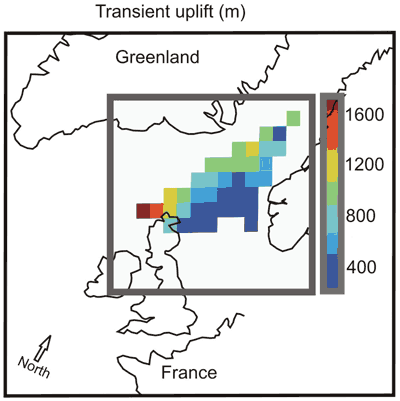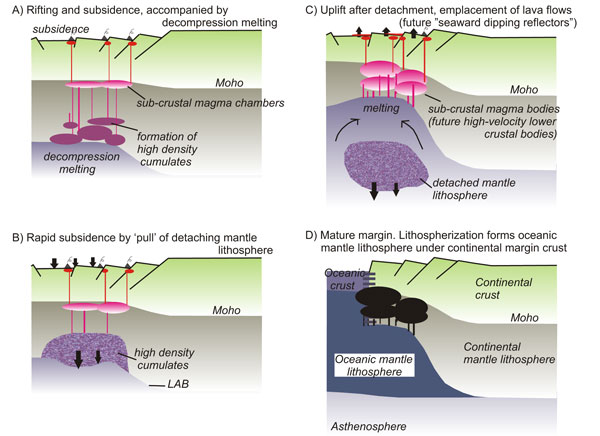 |
From Rifting to Rupture: Why Margins Rise Prior to Breaking up |
Raphael Esedo1, Jolante van Wijk2, David Coblentz3, and Romain Meyer4
1Department of Earth and Atmospheric Sciences, University of Houston, 312 Science & Research Building 1, Houston, Texas 77204, USA, rcesedo@mail.uh.edu
2University of Houston, Department of Earth and Atmospheric Sciences, jwvanwijk@uh.edu
3Los Alamos National Laboratory, Los Alamos, NM, coblentz@lanl.gov
4Centre for Geobiology and Department for Earth Science, University of Bergen, Allegaten 41, 5007 Bergen, Norway, romain.meyer@geo.uib.no
A recent literature synthesis (Esedo et al., 2012) has revealed that all rifts undergo a phase of uplift before the lithosphere ruptures. This is remarkable because rift models predict subsidence of the rift as the crust and mantle part of the lithosphere thin. What causes this uplift? We have investigated several mechanisms that explain the uplift, and developed a new conceptual model for continental breakup. In our model, a thin mantle lid causes an excess potential energy state. This leads to additional tensional forces which are required for rupture.
Stratigraphic information, apatite fission track studies, drill logs, and the present high elevation of regions such as Afar all indicate that pre-breakup uplift is a global phenomenon. This uplift occurs at both magmatic and magma-poor rifted margins.
It was recognized several decades ago that magma-dominated margins rupture around or above sea level. In the North Atlantic for example, the magmatic Norwegian and East Greenland margins erupted flood basalts sub-aerially, and the amount of pre-breakup uplift has been estimated to vary from several hundred meters to more than a kilometer (Meyer et al., 2007). More recent work shows, however, that amagmatic rifted margins undergo uplift as well. On the magma-poor Iberia-Newfoundland margins, several kilometers of pre-breakup uplift must have occurred (Peron-Pinvidic & Manatschal, 2009).

Figure 1: Transient Paleocene-Eocene boundary uplift in the North Atlantic Igneous Province. East Greenland uplift is not shown, nor are several locations that were insufficiently well constrained. Linear interpolation of the selected data points onto a regular grid with a 2° by 2° resolution. Figure taken from Meyer et al. (2007).
What causes this uplift? Possible mechanisms include:
- Uplift as a result of the arrival of a mantle plume. This mechanism has traditionally been used to explain magmatic margin uplift, but it cannot account of the uplift observed at magma-poor margins. Magma-poor margins are formed above normal temperature mantle.
- Dynamic uplift. Esedo et al. (2012) used a geodynamic model to calculate the amount of dynamic uplift related to mantle upwelling below a rift. This contributes several hundred meters to the uplift of magma-poor and magma-dominated margins, but it cannot account for the total amount of uplift.
- Phase transitions in the mantle (Simon & Podladchikov, 2008). Phase transitions during the latest stage of rifting may contribute up to ~1 km of relative uplift.
- A thin mantle lid. Isostatic calculations (Esedo et al., 2012) show that excess thinning of the mantle lithosphere during rifting, for example by detachment of the lower part, is effective in causing uplift.
We calculated the effects of a combination of these mechanisms using “fc/fl diagrams” (see Esedo et al. (2012) for details). This method allows us to examine uplift/subsidence and corresponding geoid/potential energy values in a two-dimensional parameter space of crustal- and mantle-lithosphere thicknesses. These calculations show that relative uplift of margins can best be explained by a thin mantle lid combined with an upper-mantle phase transition.

Figure 2: Conceptual model of rifted margin formation from Esedo et al. (2012). (A) Decompression melting of upwelling asthenosphere accompanies lithosphere thinning during continental rifting. Magmatic differentiation in the lithosphere results in the formation of high-density cumulates. (B) The high-density cumulates destabilize the mantle lithosphere. This results in additional subsidence of the rifted region during detachment. LAB—lithosphere-asthenosphere boundary. (C) After detachment, the surface is uplifted while melting continues, followed by continental rupture. Sub-Moho intrusions form lower crustal bodies that are observed later to have high seismic wave velocity. Lava flows are emplaced at the surface. At magma-poor margins there are few or no magmatic eruptions at this time. (D) Following continental breakup, lithospherization of upwelled asthenosphere occurs below the margin.
Based on these results, we developed a new conceptual model for rifted margin formation. In this model, the major difference between magmatic and magma-poor margins is the volume of extrusive magmatism. The mantle lithosphere detaches during the final stage of rifting, resulting in uplift and excess potential energy. This excess potential energy contributes to the tensional forces that are needed to break up continental lithosphere.
References
Esedo, R., van Wijk, J., Coblentz, D., and Meyer, R., 2012. Uplift prior to continental breakup: indication for removal of mantle lithosphere? Geosphere, 8, 1078-1085, 2012, 10.1130/GES00748.1
Meyer, R., van Wijk, J., and Gernigon, L., 2007. The North Atlantic Igneous Province: a review of models for its formation. GSA Special Paper 430, 525-552.
Peron-Pinvidic, G., and Manatschal, G., 2009. The final rifting and evolution at deep magma-poor margins from Iberia-Newfoundland. A new point of view. International Journal of Earth Sciences, 98, 1581-1597.
Simon, N., and Podladchikov, Y., 2008. The effect of mantle composition on density in the extending lithosphere. Earth and Planetary Science Letters, 272, 148-157.
last updated 18th
October, 2012 |
